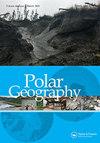北极地区的地图导航:追踪挪威救援服务中地图绘制实践中超乎人类的互动关系
IF 1.6
Q3 GEOGRAPHY, PHYSICAL
引用次数: 0
摘要
ABSTRACT 挪威北极地区的救援服务在应对事故时必须考虑天气条件、地表特征、基础设施稀缺程度和技术可用性。在某种程度上,安全导航是以使用数字地图为基础的。在本文中,我将分析地图是如何作为导航工具进行组装的,以及这与在北极地区及时应对突发事件的能力是如何相互联系的。我的研究基于新唯物主义,注重互动。我将地图作为过程进行研究,重点关注地图是如何通过实践构成的。因此,我关注超人类行动者的异质纠葛。在本文中,我重点关注与斯瓦尔巴群岛有关的地方,包括陆地事件响应、联合救援协调中心和信息支持服务。我从三个方面探讨了地图的组合:斯瓦尔巴群岛的机构地图、朗伊尔城周围的雪崩观测以及当地陆地救援服务的地图绘制实践。我认为,安全导航以及因此而产生的及时事故响应都蕴含在超越人类的网络中,并依赖于这些网络的灵活性和持久性。斯瓦尔巴群岛与大陆的测绘实践存在差异,这进一步凸显了对北极地区社会技术纠葛进行分析的必要性。本文章由计算机程序翻译,如有差异,请以英文原文为准。
Navigating maps in the Arctic: tracing more-than-human interactions of mapping practices in Norwegian rescue services
ABSTRACT When responding to an incident, Norwegian rescue services in the Arctic have to consider weather conditions, surface features, infrastructure scarcity, and technological availability. To some extent, safe navigation is based on the use of digital maps. In this article, I analyze how maps are assembled for their role as navigation tools and how this interlinks with the capacity for timely incident response in the Arctic context. My study is based on new materialism, which pays attention to interactions. I investigate maps as processes, focusing on how they are constituted through practices. Therefore, I follow heterogeneous entanglements of more-than-human actors. In this article, I focus on localities related to the Svalbard archipelago, including incident response on land, the Joint Rescue Coordination Centre, and information support services. I explore the assemblages of maps through three aspects: institutional mapping of Svalbard, avalanche observations around Longyearbyen, and mapping practices of the local rescue services on land. I argue that safe navigation, and consequently a timely incident response, is embedded in more-than-human networks and depends on their flexibility and durability. Divergence of mapping practices between those in Svalbard and on the mainland further highlights the need for an analysis of socio-technological entanglements in the Arctic.
求助全文
通过发布文献求助,成功后即可免费获取论文全文。
去求助
来源期刊

Polar Geography
GEOGRAPHY, PHYSICAL-
CiteScore
5.30
自引率
0.00%
发文量
13
期刊介绍:
Polar Geographyis a quarterly publication that offers a venue for scholarly research on the physical and human aspects of the Polar Regions. The journal seeks to address the component interplay of the natural systems, the complex historical, political, economic, cultural, diplomatic, and security issues, and the interchange amongst them. As such, the journal welcomes comparative approaches, critical scholarship, and alternative and disparate perspectives from around the globe. The journal offers scientists a venue for publishing longer papers such as might result from distillation of a thesis, or review papers that place in global context results from coordinated national and international efforts currently underway in both Polar Regions.
 求助内容:
求助内容: 应助结果提醒方式:
应助结果提醒方式:


